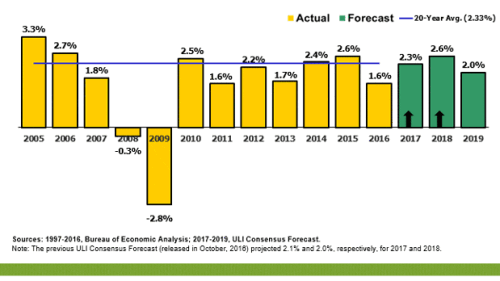Market Trends
As job growth in the professional services sector has increased substantially over the past several years, office real estate investment trusts (REITs) have benefited from strong leasing fundamentals. However, more office construction and oversupply concentrated in major metro areas such as New York City, Houston, and Washington, D.C., continue to concern those in the market. Plus, interest rate survey data from Trepp.
Brexit and the recent U.S. and French elections came up in many conversations at ULI Germany’s recent Urban Leader Summit in Frankfurt. Although panelists said they are concerned about the geopolitical changes afoot, the domestic German economy remains strong.
The latest survey of U.S. real estate economists showed a marked increase in expected economic measures, most likely due to federal proposals to reform the tax code, reduce regulatory burdens, and invest in infrastructure. Compared with the same survey from six months ago, real estate economists have higher expectations about gross domestic product (GDP) growth, employment growth, and housing starts.
The “Markets to Watch” section of the 2017 edition of Emerging Trends in Real Estate® offers an expanded look at all 78 markets included in this year’s survey, including the industry outlook for the primary markets in the U.S. Pacific Northwest. Here is the industry outlook for the primary markets in the U.S. Pacific Northwest.
According to the latest forecast from the Joint Center for Housing Studies at Harvard University, spending on home improvements is projected to strengthen in the majority of America’s largest metro areas in 2017, with many markets in the East and Midwest expected to post double-digit annual growth. The residential remodeling market reached a record high of $340 billion in 2015—surpassing its previous peak in 2007—and is projected to increase 2 percent per year on average through 2025 after adjusting for inflation.
Europe is a divided continent in many ways. While markets like Spain, Portugal, and Croatia are experiencing a surge in visitors, France, Belgium, and Turkey face a tourism crisis. Performance varies from country to country.
The U.S. property market landscape in 2017 will be characterized by continued strong fundamentals, increased investment flows, and high transaction volume, while the broader U.S. economy should continue to grow moderately and add jobs.
When it comes to the e-commerce explosion, it’s all about “the last mile,” and almost anything is imaginable. “The last mile can be executed on foot, bicycle, hand cart, unicycle, skateboard, jetpack, Uber, Lyft—the list goes on,” said Benjamin Conwell of Cushman & Wakefield, a former director of Amazon’s North American real estate operations, speaking at the 2016 ULI Fall Meeting.
Landlords are confident that apartments are not overbuilt, and rents continue to increase in many markets, but real estate investment trust investors are less certain. This year, deliveries are reaching new peaks, and investor worries about a market softening are reflected in the sector’s –1.12 percent year-to-date total return. Plus, interest rate survey data from Trepp.
Implementation of the Affordable Care Act has driven both health care–related job growth and demand for real estate in the United States. But health care REITs are not immune from external market challenges, and they have thrived in the current low interest rate environment. Plus, interest rate survey data from Trepp.






